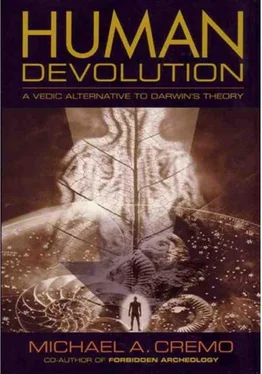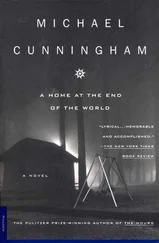Michael Cremo - Human Devolution - A Vedic Alternative To Darwin's Theory
Здесь есть возможность читать онлайн «Michael Cremo - Human Devolution - A Vedic Alternative To Darwin's Theory» весь текст электронной книги совершенно бесплатно (целиком полную версию без сокращений). В некоторых случаях можно слушать аудио, скачать через торрент в формате fb2 и присутствует краткое содержание. Год выпуска: 2003, ISBN: 2003, Издательство: Torchlight Publishing, Жанр: Старинная литература, на английском языке. Описание произведения, (предисловие) а так же отзывы посетителей доступны на портале библиотеки ЛибКат.
- Название:Human Devolution: A Vedic Alternative To Darwin's Theory
- Автор:
- Издательство:Torchlight Publishing
- Жанр:
- Год:2003
- ISBN:9780892133345
- Рейтинг книги:4 / 5. Голосов: 1
-
Избранное:Добавить в избранное
- Отзывы:
-
Ваша оценка:
- 80
- 1
- 2
- 3
- 4
- 5
Human Devolution: A Vedic Alternative To Darwin's Theory: краткое содержание, описание и аннотация
Предлагаем к чтению аннотацию, описание, краткое содержание или предисловие (зависит от того, что написал сам автор книги «Human Devolution: A Vedic Alternative To Darwin's Theory»). Если вы не нашли необходимую информацию о книге — напишите в комментариях, мы постараемся отыскать её.
Human Devolution: A Vedic Alternative To Darwin's Theory — читать онлайн бесплатно полную книгу (весь текст) целиком
Ниже представлен текст книги, разбитый по страницам. Система сохранения места последней прочитанной страницы, позволяет с удобством читать онлайн бесплатно книгу «Human Devolution: A Vedic Alternative To Darwin's Theory», без необходимости каждый раз заново искать на чём Вы остановились. Поставьте закладку, и сможете в любой момент перейти на страницу, на которой закончили чтение.
Интервал:
Закладка:
A theory based on the vedic model of the cosmos could account for all of the above. Matter, mind, and individual spirits emanate from God. God enters into each atom and accompanies each individual spirit as the Supersoul, or Paramatma. The Supersoul, by definition, is present in all phases of time and space, and is simultaneously beyond time and space. The Supersoul is also all knowing. Therefore, through the medium of the Supersoul, knowledge can be transmitted from one spirit to another beyond the usual limits of time and space. There are many examples of this in the vedic literature. The Bhagavad Gita (15.15) says that it is from the Supersoul that each individual souls gets memory, knowledge, and forgetfulness. The Supersoul can therefore control the kind and amount of information that comes to each individual soul, whether through normal or paranormal means. Since the Supersoul is present in each atom of matter and is at the same time aware of conscious intentions, it is possible for the Supersoul to produce the effects associated with random number generators. Responding to the desires of experimenters and the intentions of subjects, the Supersoul could cause more ones or zeros to come up in the course of the experiments. The vedic model, which posits the existence of an eternal conscious self ( atma ), would explain evidence for survival of bodily death. According to the vedic model, the eternal conscious self, if it does not return to the spiritual level of reality, remains in the material world covered by a subtle mental body. This mental body is composed of a subtle material element (mind) that can, by the agency of Supersoul, affect ordinary matter. This would explain poltergeist effects and apparitions. The mental body also includes a subtle sensory apparatus, capable of operating without the assistance of the ordinary bodily sense organs. This would explain the visual perceptions that subjects report during out-of-body experiences. The vedic model has considerable explanatory power.
This model overcomes the classic objection to the cartesian duality of mind and matter. descartes’s terminology identifies mind with consciousness. A popular, but incorrect view, is that descartes thought that the pineal gland in the brain mediated an interaction between mind (consciousness) and matter. This organ was, according to this account, sensitive to both mind and matter and could link them. Modern philosophers now believe that descartes simply suggested that the pineal gland was the place where an interaction between mind and matter took place. As to how the interaction actually took place, descartes could not say (Griffin 1997, p. 105). nicolas Malebranche and Arnold Geulincx, two of the principal followers of cartesian philosophy, accepted descartes’s formulation that mind and matter were distinct entities and concluded that they could not interact. They proposed to explain, however, their apparent interaction through the philosophical doctrine of occasionalism. Griffin (1997, p. 105) explains: “According to this doctrine, on the occasion of my hand’s being on a hot stove, God causes my mind to feel pain, which leads me to decide to move my hand. My mind, unfortunately, cannot cause my body to move any more than my body could cause my mind to feel pain. On the occasion of my deciding to move my hand, accordingly, God obliges, moving it for me. All apparent interaction between mind and body is said to require this constant supernatural intervention.”
The vedic model of the relationships between matter, mind, and consciousness resembles occasionalism. In the vedic model, mind (a subtle kind of matter) is placed along with ordinary matter on one side of the cartesian divide. The soul, a unit of pure consciousness, is placed on the other side. The question still arises, how can any connection between the soul (consciousness) and matter in its two forms (ordinary matter and the subtle material mind) be established? The key is the Supersoul. The Supersoul is the ultimate source of the souls of living beings as well as the mind element and ordinary matter. The Supersoul monitors the desires and intentions of the souls of living beings and causes mind and matter to transform in response to those desires. The vedic model also incorporates the property dualism of Spinoza, who proposed that there is actually only one substance, spirit, that is perceived differently according to its application, just as electricity can be used to heat or cool. The Supersoul possesses a spiritual potency which it can deploy in different ways. The spiritual potency when deployed to cover the original spiritual consciousness of the individual soul is known as matter. But the same potency can be changed back to its original spiritual form by the Supersoul.
Supersoul may explain a puzzling anomaly in consciousness studies. Benjamin Libet, a neuroscientist, has reported the results of experiments about intention and brain state. He asked his subjects to bend a finger at the exact time they made a decision to do so. Study of brain waves revealed that there was a gap of about one-fifth of a second between the time the subject decided to move their fingers and the time the muscles in the finger actually moved. But the same study also revealed that the brains of the subjects displayed activity a third of a second before the subjects consciously reported making a decision to move their finger. Libet took this to mean that our conscious free will is not really free, but is reflecting some unconscious brain action that precedes the decision’s entry into our conscious awareness. Accordingly, free will is largely an illusion (Libet 1994; in Radin 1997, pp. 283–284). But this is not necessarily so. According to the vedic model, the Supersoul, on a deep level, is monitoring the soul, the actual conscious self. Anticipating the desire of the soul to move the finger, the Supersoul could set the process in motion before the desire is manifested as a mental intention.
In their book margins of Reality (1987), Robert G. Jahn and Brenda J. dunne gave a theory that makes use of analogies from quantum mechanics and at the same time accounts for the action of consciousness in a way that is compatible with the vedic model. Like the vedic model, their model appears to accept unit consciousness as a feature of reality. Jahn and dunne proposed that consciousness has a dual particle/wave nature, much like the atom or photon in quantum mechanics. They proposed that our normal individual embodied consciousness might be likened to “probability of experience waves” that are “confined to some sort of ‘container,’ or ‘potential well,’ representative of the environment in which that consciousness is immersed” (Jahn and dunne 1987, p. 242). Ordinary conscious relations would be defined by the interactions of the confined waves, according to the conditions imposed by the physical body and environment. But just as in quantum mechanics there are tunneling effects, whereby the consciousness wave in a particular potential well can influence the consciousness wave in another potential well in ways not normally allowed. This might, according to Jahn and dunne (1987, p. 243), “represent various types of anomalous information acquisition, including remote perception and remote PK effects.” Jahn and dunne added (1987, p. 243), “If any of the standing wave systems acquires sufficient energy to be elevated from cavity-bound to free-wave status, it may gain access to all consciousness space-time and interact with any other center in the configuration via that mode. Thus, this route could accommodate a variety of anomalies, including remote perception and remote man/machine interactions, as well as more extreme and controversial phenomena such as mystical union, out-of-body experiences, mediumship, and spiritual survival.” The question is: how does a “standing wave system” (atma, or soul, in the vedic model) acquire the “sufficient energy” to get out of an energy well? Here the Supersoul could play a role. Only the Supersoul would possess enough energy not to be bound in any way by any of the energies. But it could contribute enough energy to individual units of consciousness to break out of their limitations. But such units of consciousness could never achieve the same degree of freedom as the Supersoul and would require constant connection with the Supersoul to remain in the free state.
Читать дальшеИнтервал:
Закладка:
Похожие книги на «Human Devolution: A Vedic Alternative To Darwin's Theory»
Представляем Вашему вниманию похожие книги на «Human Devolution: A Vedic Alternative To Darwin's Theory» списком для выбора. Мы отобрали схожую по названию и смыслу литературу в надежде предоставить читателям больше вариантов отыскать новые, интересные, ещё непрочитанные произведения.
Обсуждение, отзывы о книге «Human Devolution: A Vedic Alternative To Darwin's Theory» и просто собственные мнения читателей. Оставьте ваши комментарии, напишите, что Вы думаете о произведении, его смысле или главных героях. Укажите что конкретно понравилось, а что нет, и почему Вы так считаете.












